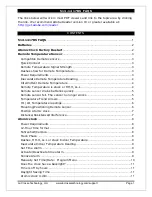
La Crosse Technology, Ltd. www.lacrossetechnology.com/support
Page 8
Interference:
•
Consider items in the signal path between the remote sensor and the
atomic clock.
•
Sometimes a simple relocation of the remote sensor or the atomic clock will
correct the interference.
•
Windows can reflect the radio signal.
•
Metal will absorb the RF (radio frequency) signal.
•
Stucco has a metal mesh that absorbs signal.
•
Avoid transmitting antennas: (ham radios, emergency dispatch centers,
airports, military bases, etc.)
•
Electrical wires (utilities, cable, etc.)
•
Vegetation is full of moisture and reduces signal.
•
It is difficult for RF (radio frequency) signal to travel through a hill.
Atomic clock
Power Requirements
•
2-AA alkaline batteries may be used.
12-Hour time format
•
Time can display in 12-hour only
Fahrenheit/Celsius
•
Use the
to switch between Fahrenheit and Celsius.
Moon Phase
The moon phase is based on the lunar calendar and the year, month and date set.
Most Internet moon phase calculations are based on the lunar calendar.
•
Waxing
indicates growing or expanding illumination and happens after a
new moon.
•
Waning
indicates decreasing illumination and occurs after a full moon.
•
Crescent
refers to the moon being less than half illuminated. Crescents can
be waning or waxing.
•
Gibbous
describes a moon phase when more than half is illuminated.
Gibbous can be waxing or waning.
•
New Moon
occurs when the moon is between the earth and sun, so the
illuminated portion of the moon is on the back side facing the sun and we
cannot see it. After a new moon, the illuminated portion will increase or wax
until the full moon occurs.
•
Full Moon
occurs when the earth, moon and sun are in approximate
alignment, with the moon and the sun on opposite sides of the earth. The
illuminated portion of the moon faces the earth, giving us complete visibility
of one side of the entire moon. After a full moon, the illuminated portion will
decrease or wane until the new moon occurs.
•
First Quarter
and
Last Quarter
moons occur when the moon is at a 90
degree angle to the earth and sun. We see half of the moon illuminated and
the other half is in shadow.












